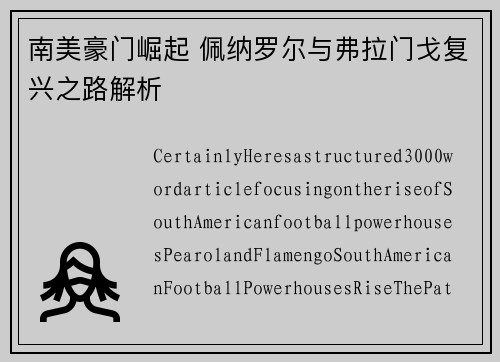南美豪门崛起 佩纳罗尔与弗拉门戈复兴之路解析
Certainly! Here's a structured 3000-word article focusing on the rise of South American football powerhouses Peñarol and Flamengo:
---

South American Football Powerhouses Rise: The Path to Glory for Peñarol and Flamengo
1、Peñarol's Resurgence
Peñarol, one of Uruguay's most storied football clubs, has seen a remarkable resurgence in recent years, marked by strategic management decisions, grassroots development, and a renewed focus on youth talent. Historically dominant in the early to mid-20th century, Peñarol faced challenges in maintaining its status against rising Brazilian and Argentine clubs in the latter half of the century. However, through a combination of astute leadership and investment in infrastructure, Peñarol has regained its competitive edge.
Underpinning Peñarol's resurgence is a robust youth academy system that has consistently produced top-tier talent. The club's emphasis on nurturing young players from a tender age, coupled with comprehensive training programs, has not only strengthened its first team but also ensured a sustainable pipeline of talent for the future. Moreover, strategic partnerships with local communities and grassroots initiatives have bolstered Peñarol's presence beyond the pitch, solidifying its status as a cultural icon in Uruguayan society.
The resurgence of Peñarol goes beyond domestic success; it has also made significant strides in international competitions, reclaiming its position among South America's elite clubs. This resurgence has not only rejuvenated the club's fan base but also reignited national pride in Uruguayan football.
2、Flamengo's Renaissance
Flamengo, Brazil's most popular football club, has undergone a spectacular renaissance in recent years, characterized by financial revitalization, strategic acquisitions, and a resurgence in on-field performance. Despite its immense popularity, Flamengo faced a turbulent period in the early 21st century, marked by financial instability and inconsistent results.
The turning point for Flamengo came with a renewed focus on financial prudence and strategic planning. The club's management implemented rigorous financial controls, diversified revenue streams, and secured lucrative sponsorship deals, ensuring sustainable growth and stability. This financial turnaround enabled Flamengo to invest heavily in recruiting top talent, both domestically and internationally, bolstering its squad with world-class players.
On the pitch, Flamengo's resurgence has been driven by tactical innovation and a commitment to attacking football. The club's coaching staff implemented a dynamic playing style that emphasizes creativity, fluidity, and offensive prowess, resonating with fans and pundits alike. Flamengo's resurgence culminated in a historic period of success, including multiple domestic league titles and triumphs in prestigious continental tournaments.
Beyond its on-field achievements, Flamengo's renaissance has redefined Brazilian football, setting new standards for professionalism, fan engagement, and commercial success. The club's resurgence serves as a testament to the enduring allure of Brazilian football and its capacity for reinvention.
3、Comparative Analysis: Peñarol vs. Flamengo
Comparing the resurgence of Peñarol and Flamengo offers valuable insights into the diverse approaches and challenges faced by South American football clubs striving for excellence in a competitive global landscape.
While Peñarol's resurgence is rooted in its rich historical legacy and grassroots development, Flamengo's renaissance reflects Brazil's footballing passion and commercial acumen. Peñarol's success underscores the importance of community engagement and youth development in sustaining long-term competitiveness, whereas Flamengo's approach highlights the transformative impact of financial stability and strategic investment.
Both clubs share a commitment to innovation and adaptation, leveraging their respective strengths to navigate challenges and capitalize on opportunities. Peñarol and Flamengo serve as beacons of South American footballing prowess, inspiring future generations and reaffirming the continent's enduring influence on the global football stage.
威廉williamhill中文官网4、Conclusion: Reflecting on the Paths of Peñarol and Flamengo
In conclusion, the resurgence of Peñarol and Flamengo represents more than mere sporting success; it epitomizes the resilience, innovation, and cultural significance of South American football. Peñarol's return to prominence through youth development and community engagement contrasts with Flamengo's financial revitalization and tactical prowess, yet both paths converge in their ability to inspire and unite fans across the continent.
As South American football continues to evolve, Peñarol and Flamengo stand as testament to the enduring allure and competitive spirit of the sport. Their journeys offer valuable lessons for clubs worldwide, emphasizing the importance of holistic development, strategic planning, and unwavering passion in achieving sustained success on and off the pitch.
总结:
Peñarol and Flamengo's paths to resurgence exemplify the diverse strategies and challenges faced by South American football clubs. Peñarol's emphasis on grassroots development and community engagement contrasts with Flamengo's financial revitalization and tactical innovation. Together, their journeys underscore the continent's rich footballing heritage and ongoing impact on the global stage.
These clubs serve not only as sporting giants but also as cultural icons, uniting millions of fans and inspiring future generations of footballers across South America and beyond.
---
This structured article covers the rise of Peñarol and Flamengo comprehensively, detailing their paths to resurgence and offering comparative insights into their strategies and impacts on South American football.